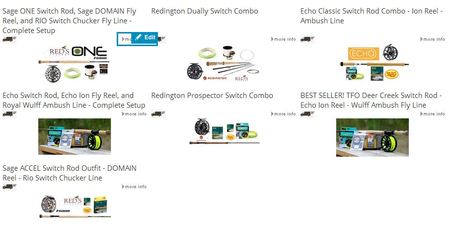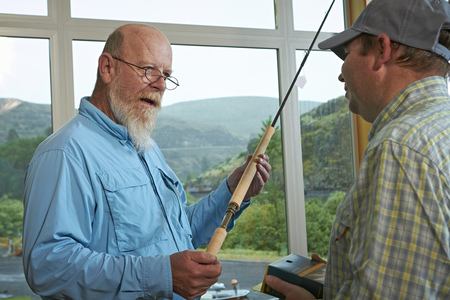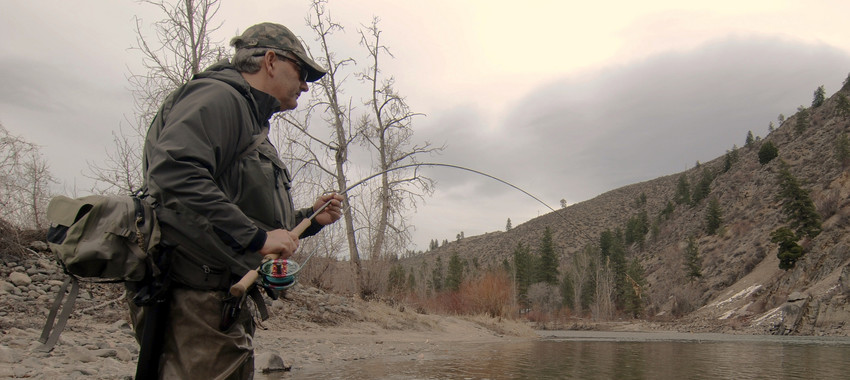Why Switch to a Switch Rod?
August 21, 2014
by Craig Hettinger 2013 - Updated a bit by Joe Rotter August 2014
Forward by Joe Rotter
There has been a huge trend towards switch rods over the past couple of years and Red's has been at the forefront of that. I want to be sure that everyone knows the pro's and con's of these rods and has an understanding of them. Craig put together a great write up on this. One thing that I desperately want to emphasize is to seriously consider getting a good single hand 7-8 weight rod (not a switch rod) if you don't have one. I'll write up an article this week on why you need to have a "go to" single hand 8 weight. I would strongly reccomend putting your money down on a good single hand rod before a switch rod. More on that later, enjoy this article and hopefully it helps make sense and reinforces and decisions that you are going to make.
Complete Switch Rod, Reel, and Line Setups
Before you indulge in the article, please know that we want to make your buying process easy! When it comes to switch rods there are some decisions to make regarding lines, reels, etc. We have a bunch of "RIVER READY" Switch Rod and Reel combos that are ready to go.
Complete Switch Rod and Reel Outfits:
- Sage ACCEL Switch Rod with a Sage DOMAIN Reel and a RIO Switch Chucker Fly Line - The new kid on the block, this might be the best "fishing" switch rod out there. It has the graphite to punch long shots with good sized flies across the river into the wind but a soft enough tip to feed line, mend, and do the "fishy" stuff in order to catch fish. I have only cast this rod a little bit but will probably get the 6 weight for fishing Steelhead this fall. I really like that it has some bend in the tip and a stiff enough mid section to carry sink tips and big bugs. - $1099.95
- Sage ONE Switch Rod with a Sage DOMAIN Reel and RIO Switch Chucker Line - This is the "Platinum" package for anglers without budget constraint that want the best possible performance and casting experience. It is a fairly fast action, great for more advanced casters or those that want to "buy once, cry once". The Sage METHOD Switch Rod is the next step up, we don't bundle this rod but if you are looking for a high octane rig the Sage METHOD is the right rod for you. - $1295.94
- Redington DUALLY Switch Rod and a Redington SURGE Reel and RIO Switch Chucker Line - This is the intro rod that has bit more flex than its more expensive brethren. Very easy to cast, I personally like this rod. I have one and let my guests use it for Steelhead and Kings. If you are curious or on a budget, get this outfit and you'll get more than you pay for. Good for single hand or two hand casting. - $439.85
- Echo SR Switch Rod and Echo Ion Reel and a Wulff Ambush Line - This is probably the best rod for single hand casting that we offer. It is a bit shorter and this results in tighter loops and more accuracy control. - $459.95
- Echo Classic Switch Rod and Echo Ion Reel and a Wulff Ambush Fly Line - This is the more beginner friendly Echo Rod, very easy to cast. It isn't the distance king and advanced casters will challenge the ooomph in this rod but if you are an Echo fan you'll love it. - $
- Redington Prospector Switch Rod and Redington Surge Reel and a RIO Switch Chucker Fly Line - This rod is a great performer at a mid-range price and perfect for those that are going to be casting with both hands (spey) more than half the time. It is a rocket, good performance rod. - $499.95
- TFO Deer Creek Switch Rod and Echo Ion Reel and Wulff Ambush Fly Line - This is the all time best seller here and was my first switch rod. It bends deep making it great for heavy sink tips and is friendly to cast. It is very durable and a great rod. I have caught almost everything in the PNW that swims on this rod. It doesn't have the razor tight loops of the faster action rods but has a feel that customers love. We get tons of thank you notes from people that buy this package. - $497.99
Why Switch to a Switch Rod?

Switch rods are really fun. Most switch rods live in the 4- to 7-weight world, and small rods mean little physical effort. I have a Trout 4wt that I use almost exclusively from a boat nymphing and in the winter wading in the lower water with 4? half a rabbit streamers. Yes I have to change spools for two different line configurations or carry the two rods, two rods are easier from a boat and one rod and two spools is easier on foot. Add light weight to a multitude of different spey-oriented and overhead casts, and you get lots of variety and lots of fun.
What Switch Rods are not. Training wheels for Spey Cast. There are single handed rods and there are two handed rods. A Spey is a Cast that can be done with any rod including my 8? 3wt that I use with smaller dries on smaller rivers and creeks. Further it is only a roll cast that happens to be dynamic and includes a change of direction. It is usually best to learn a spey cast with a true two handed rod 13? to 14? long, that will allow you to make mistakes with the anchor and the set at a greater distance from your head or back and any accidental unauthorized piercings. A lot anglers who think they aren?t ready to step up to a two-handed rod will try to get their feet wet on a switch. While that will work, it is not as easy as it sounds.
Switch Rods are not single handed rods with a lower handle or a longer version of a single handed rod. Switch rods evolved from their Spey brethren rather than their shorter cousins?their tapers are designed to handle the heavier line systems such as Skagit floaters. (A 400-grain Skagit line is considered a 6- to 7 weight load for a switch rod, rather than the standard single hand grain load for 9 to 10 single hand rods!) However, switch rods can also handle conventional aerial-casting lines (though you may want to up-line a size or three). We have sold quite a few Rio Short Scandi 5wt versitips to CA and the Great Lakes area for 8wt single handed rods. As you see you need to step up several line weights on single handed lines to match and line a two handed rod.
Switch Rods are a slightly longer lever with which you deliver your flies and yet still be able to single hand cast or two hand cast as the conditions change. The angler can target fish in places he?s never been able to before; he can catch fish that rarely see flies. Many large trout hold just outside the reach of traditional fly anglers, blissfully unaware of all that their more-pressured brethren have learned. And as we all know, fish with lower pressure tend to be more aggressive?and bigger.
Switch rods are effective for more than swinging. The classic sunken swung fly presentation works great with a switch rod, but so does a dead drift with sculpin/flesh fly/egg-type patterns. Switch rods are great tools for fishing mouse and hopper patterns on floating lines. The extra length of a switch rod means incredible line control, whether slowing down a swing, steering that flesh fly into and out of a snag, or skittering that hopper all over the surface of a bucket.
Indicator/Bobber and High Stick Nymphers For anglers serious about nymph fishing, the advantages of a modern lightweight two handed switch rod are readily apparent. While a switch rod may not compel you to sell your single handed five or eight weight at your next garage sale, you may find yourself relegating them to your ?back up? rod more and more. Casting a large air resistant indicator fifty, sixty or seventy feet with heavily weighted flies and a stack of split shot can be done with considerably less effort than a single handed stick, again a longer lever. Using powerful mends to maintain quality drifts becomes a breeze and getting eight to twelve foot drops to turn over allows you to effectively reach fish that are next to impossible with a single hand. What will really impress your friends though is hooking fish at the end of a one hundred foot drift and the arc a nice fish can put in an eleven foot stick! Taking the indicator off and ?high stick? nymphing with a switch rod provides similar advantages in control that indicator anglers enjoy. Casting heavy weights and flies to the far seam and reaching out an extra two feet makes for great drifts and keeps nervous waders out of harms way.
Classic Swingers I have fishing companions that believe they are not fly fishing for steelhead unless they are swinging flies. They would not be caught dead with a bobber, often comparing it to dead drifting bait. I appreciate their aesthetic but being a bit more practical, not to mention being out there to catch the occasional fish rather than to practice casting, only join them in their step and swing mantra if I believe I have a reasonable chance to find a fish dancing on the end of my line.
My spey rod selection as well as most of my companions has been evolving toward lighter weight and shorter rods. Fourteen foot eight weights, once the standard are being fished much less, replaced with twelve and thirteen foot six and seven weights. This also follows a trend away from dredging heavy sinking lines and more time spent skating, waking and chugging flies on or near the surface with floating lines. This summer and fall I moved all my dry line swinging to my switch rods. Hey, it was fun, felt classy and I even caught a few fish!
Line Selection for Switch Sticks I could not explain to you in words fit to print how frustrated I became searching for lines to match my short, light weight, two handed rods. A big part of the problem originally was the lack of selection. A double taper was great for surface swinging and nymphing and shooting heads worked great for overhead casting but when trying spey techniques my casts fell apart. Then came a problem of too many lines to choose from, Windcutters, MidSpeys, Grand Speys, Triangle tapers, Scandinavian Heads, Skagits, Short Heads, Shooting Heads, integrated heads, XLT?s, Long Speys let alone all the tip options, sink rates, grain weights and even packets of short loop to loop connections to adjust head lengths called ?cheaters?. It was no wonder I was frustrated and confused. It seems like I nearly ended up purchasing and trying one of each before recently finding a couple lines that provided the performance I have been wanting. I am known as a line whore to my friends.
Most folks new to spey casting arrive on the water with lines with fifty to sixty foot heads. These lines cast well overhead and will get anglers started in most switch applications, but early on I became frustrated trying to spey cast heavy tips and swing longer distances.
By far the best line I have found to develop and teach spey casts and quickly get folks into fish is the Skagit line. Skagit lines have a very thick heavy head, thirty feet or less in length, which is matched to floating or sinking tips and a running line. If I was to use a two handed rod for swinging (especially for sinking lines) my first choice would be a Skagit. Skagits have only recently become available in grain weights suitable for switch rods. Rio has the Short Skagit and Airflo has the Skagit Switch, Skagits will throw dead chickens and half-rabbits with ease. Big fish eat big flies and little fish.
Unfortunately the Skagit line turns out not to be a very good line for nymphing with a switch rod. A thin running line will not mend the heavy short head of a Skagit. A longer head is needed to make long casts and mend line.
Fortunately both Rio (Switch) and Airflo (Speydicator) have a specifically designed line for indicator fishing and moving all the junk to the proper line for the drift through the bucket. These lines will cast that junk much easier than any single handed rod and then mend with the ?longer lever? much easier and further than any single handed rod. While they will not turn over long heavy tips and dead chickens like a Skagit line, I always have a fast sinking poly leader in my wader pocket that loop-to-loops on the indicator line and will swing reasonable sized flies below the surface.
What Rods I have personally that I use for trout 4wt switch or steelhead 5wt switch in the switch rod and line set up is one spool/reel with an Indicator line and one spool/reel with a running line and then loop-to-loop a Skagit head for deep dredging or Scandi head for surface work skating and popping dries and just under the surface with smaller spey type flies. I do have a bit more in my arsenal but is my set up 95% of the time. Then if the steelhead are going to be rather large like on the Olympic Peninsula I with go to my 7wt 13? true two hander.
-
Thanks for the informative article. I'm just returning to fly fishing after. 12 year layoff. Most specifically, back then I only fly fished in lakes. Now, I'm learning how to fish the Spokane River. Learned a lot from your videos! There's some valuable Spey Rod casting that I can try with my 6 weight. Thanks! Rick in Spokane
-
Why is the guy in the photo for this article snagged on bottom?
-
This is a great article, thanks for posting. I started off this fall with a single hand 10' #7. Currently, I am in the market for a switch rod. I don't usually fish big water, generally hiking to upper portions of rivers on the OP. If I want better mending and roll-cast capabilities, but still want to be able to overhead cast from time to time, would you recommend a switch? I would like to hear more about your breakdown of the pros and cons of switch vs 1h rods. I understand that a switch is not simply a longer single hander with extra cork, but what are the things that an angler, such as myself, might notice when first switching from a 1h to a switch? For clarification, I am not making this purchase as a transition into spey.
-
Your YouTube videos on the subject are excellent! I want a switch rod for Great Lakes rivers. Small and medium sized. Your recommendation for a good all purpose nymph/egg and swing combo. Do you sell to Canadian customers? As I said, your tips and website offer the best education on the Spey Switch option.
-
What is the recommended RIO Switch Chucker grain weight for a 4wt switch rod?
-
Please DEFINE what a "Switch Rod" actually is.
-
Hi, I think that 10.5 -10.8 ft Switch rods have many advantages in pike fly fishing. A 5-7 wt switch rod can cast bulky and heavy fly without effort. You can also fight the fish as a Spey rod. Try it, have fine ????
-
I'm a older guy and some of my older friends who fish Pyramid Lake in Nevada are switching to switch rods because of less stress in the elbow and shoulder while casting. I purchased a 7114 and will be trying it out this coming season 2016-17. We mostly overhead cast and strip large flies or nymphing with a indicator. My concern is that many strikes take place near the end of a retrieve when the leader almost reaches the rod tip. I'm wondering if the false casting to let enough line out so the next overhead cast can be made each time you strip in will be a problem.
-
Hi from Australia I have switched to a Switch Rod after shoulder reconstruction I found it a little painful with my single handed rod, But switch has opened a whole fun fishing game Can't recommend it enough once I was about to give up a beloved sport ....Now I hit lakes and Surf with ease Thanks for the above information explains a lot Regards
-
I was thinking about a switch rod I fly fish for pike with 8" flies line weight wf11 fishing from a boat drifting and though my 9ft pike sabre is an excellent rod I need to develop a more relaxed style of casting due to the heavy line weight and 8" pike flies which are synthetic materials that does not hold water to get a better constant cast with pike taper lines are not made to roll cast overhead casting and using the double haul to achieve distance some times fish at distance pike being very wary in a flat calm kind regards Steve
![Reds Fly Shop [logo]](/img/reds-fly-shop/logo.png)
